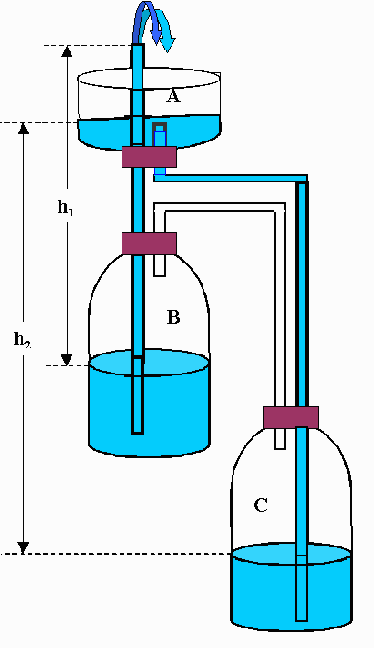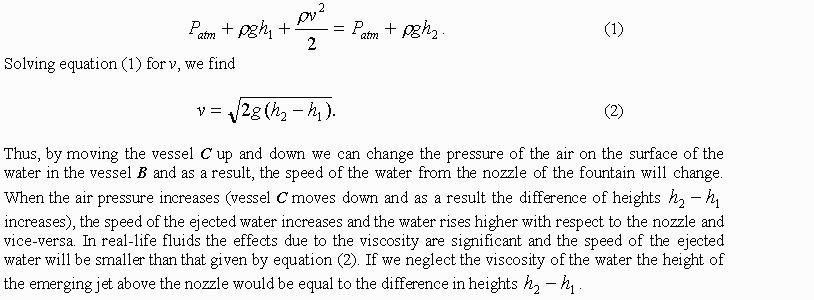Name: Roman Kezerashvili
Address: New york City Technical College Department of
Physics 300 Jay Street Brooklyn, NY 11201
Phone: 718 260 5277
E-mail; Rkezerashvili@nyctc.cuny.edu or rkezeras@liu.edu
Alexander Sapozhnikov
Address: 2261 Ocean Avenue Apt.3F, Brooklyn, NY 11229
Phone (718) 3824966 Fax
E-mailPhone alexs@brooklyn.cuny.edu
Low-Cost Competition
Apparatus Title: Hero's Fountain
Abstract:
Hero's fountain is dramatic and one of the best demonstration
of the topic "Liquids". A new simply constructed, easy-to-make demonstration
of the Hero's fountain is presented. Its action is discussed on the basis
of Pascal's and Bernoulli's principles.
Equipment required to construct apparatus: To make
the magic fountain you need three 2-liter plastic soda bottles, three rubber
stoppers #3 with two ¼ '' (0.006 m) holes each, two pieces of plastic
tubing about 2½' (0.8 m) long and ¼ '' glass tube about 3'
(1 m) long.
Item Source/Store Part Number Cost
Total cost: less then $10
Description
 Figure
1 incorporates a schematic drawing for Hero's fountain. The fountain consists
of three parts: a cup A with the fountain tube, and two vessels B and C.
The parts are connected as shown in Figure 1. The vessel B is filled with
water and the vessel C is empty. Cup A is placed on the vessel B and connected
with the vessel C by a hose. Vessel B with the cup can be placed on a table
and the other one under the table. When you pour water into the cup A,
the water from the cup flows to the lower vessel C, which contains air,
and produces the hydrostatic pressure P2 = rho g h2, additional to the
initial atmospheric pressure Patm, of the air in the vessel C. As a result
the pressure forces air up to the upper vessel and according to the Pascal's
Principle the air transmits this pressure to the water in the upper vessel
B. The pressure that air exerts on the water in the vessel B, oppose the
atmospheric pressure and the hydrostatic pressure P1 = rho g h1 . Thus,
the compressed air in the vessels B and C forces the water to spout out
of the fountain's upper tube and drives the fountain.
Figure
1 incorporates a schematic drawing for Hero's fountain. The fountain consists
of three parts: a cup A with the fountain tube, and two vessels B and C.
The parts are connected as shown in Figure 1. The vessel B is filled with
water and the vessel C is empty. Cup A is placed on the vessel B and connected
with the vessel C by a hose. Vessel B with the cup can be placed on a table
and the other one under the table. When you pour water into the cup A,
the water from the cup flows to the lower vessel C, which contains air,
and produces the hydrostatic pressure P2 = rho g h2, additional to the
initial atmospheric pressure Patm, of the air in the vessel C. As a result
the pressure forces air up to the upper vessel and according to the Pascal's
Principle the air transmits this pressure to the water in the upper vessel
B. The pressure that air exerts on the water in the vessel B, oppose the
atmospheric pressure and the hydrostatic pressure P1 = rho g h1 . Thus,
the compressed air in the vessels B and C forces the water to spout out
of the fountain's upper tube and drives the fountain.
Hero's fountain is also a good demonstration for Bernoulli's
principle. Let us consider again the fluid as an ideal, and determine the
speed of the ejected water from the nozzle of the fountain. Use the Bernoulli's
principle at the top of the water in the vessel B and the nozzle. The vertical
motion of the top of the water in the vessel B is an insignificant. Therefore,
the vertical speed of the water at the top in the vessel B is negligible
compared with the speed v of the emerging stream of water from the nozzle
of the fountain and Bernoulli's equation becomes

 Figure
1 incorporates a schematic drawing for Hero's fountain. The fountain consists
of three parts: a cup A with the fountain tube, and two vessels B and C.
The parts are connected as shown in Figure 1. The vessel B is filled with
water and the vessel C is empty. Cup A is placed on the vessel B and connected
with the vessel C by a hose. Vessel B with the cup can be placed on a table
and the other one under the table. When you pour water into the cup A,
the water from the cup flows to the lower vessel C, which contains air,
and produces the hydrostatic pressure P2 = rho g h2, additional to the
initial atmospheric pressure Patm, of the air in the vessel C. As a result
the pressure forces air up to the upper vessel and according to the Pascal's
Principle the air transmits this pressure to the water in the upper vessel
B. The pressure that air exerts on the water in the vessel B, oppose the
atmospheric pressure and the hydrostatic pressure P1 = rho g h1 . Thus,
the compressed air in the vessels B and C forces the water to spout out
of the fountain's upper tube and drives the fountain.
Figure
1 incorporates a schematic drawing for Hero's fountain. The fountain consists
of three parts: a cup A with the fountain tube, and two vessels B and C.
The parts are connected as shown in Figure 1. The vessel B is filled with
water and the vessel C is empty. Cup A is placed on the vessel B and connected
with the vessel C by a hose. Vessel B with the cup can be placed on a table
and the other one under the table. When you pour water into the cup A,
the water from the cup flows to the lower vessel C, which contains air,
and produces the hydrostatic pressure P2 = rho g h2, additional to the
initial atmospheric pressure Patm, of the air in the vessel C. As a result
the pressure forces air up to the upper vessel and according to the Pascal's
Principle the air transmits this pressure to the water in the upper vessel
B. The pressure that air exerts on the water in the vessel B, oppose the
atmospheric pressure and the hydrostatic pressure P1 = rho g h1 . Thus,
the compressed air in the vessels B and C forces the water to spout out
of the fountain's upper tube and drives the fountain.
